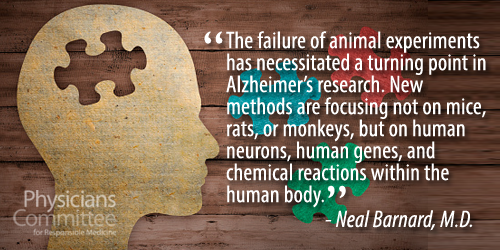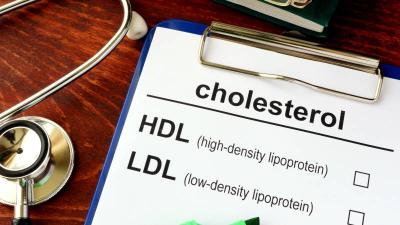World Alzheimer’s Day Sept. 21: Advance Research Without Animals

Since 99.6 percent of Alzheimer’s drugs that test successfully in animals fail in humans, many researchers are turning toward promising new human-based technologies.
Since 99.6 percent of Alzheimer’s drugs that test successfully in animals fail in humans, many researchers are turning toward promising new human-based technologies. In advance of World Alzheimer’s Day on Sept. 21, I’m sharing Alzheimer’s Research Without Animals from the Physicians Committee’s upcoming issue of Good Medicine.
Here’s my editorial from the issue:
As American soldiers returned from the war in 1945, obstetrics clinics got ready for the Baby Boom. And 70 years later, geriatric clinics are doing the same. Over the next 10 years, half of the surviving Baby Boomers will develop Alzheimer’s disease.
The looming crisis turns out to be a bonanza for researchers who are busy breeding mice and other animals with brain disorders that are intended to simulate Alzheimer’s, seeking to turn up a marketable drug. Federal grants for Alzheimer’s research are an estimated $566 million and have risen dramatically due to special government funding in recent years.
From an animal welfare standpoint, the situation could hardly be worse. To produce animals with genetic peculiarities, biological suppliers breed them by the thousands, and those who do not match up to the expected genetic profile are simply discarded. Those who survive to begin experiments have a far worse fate, before they too are finally killed.
From a human standpoint, the situation is similarly bleak. Of more than three dozen drugs tested in humans after appearing promising in animals, not a single one has been an effective treatment. Of the few medications that are used to treat Alzheimer’s, none actually changes the course of the disease.
The failure of animal experiments has necessitated a turning point in Alzheimer’s research. New methods are focusing not on mice, rats, or monkeys, but on human neurons, human genes, and chemical reactions within the human body. At Harvard University, the "Alzheimer’s-in-a-dish” technology should allow scientists to test new drugs much faster and more accurately than was possible with animals.
Perhaps the most exciting new research is zeroing in on diet and lifestyle. Just as, a generation ago, large population studies identified risk factors for heart disease—cholesterol, blood pressure, smoking, and obesity, among others—all of which were then confirmed in randomized clinical trials, the same risk-factor pathway is bearing fruit in Alzheimer’s. The Chicago Health and Aging Project showed that saturated and trans fats (“bad” fats) and excess copper intake are linked to greatly increased risk, while other parts of the diet, notably vitamin E, reduce risk. Other researchers have shown how physical exercise can reverse the shrinkage of the brain’s memory centers and combat cognitive decline.
The shift in research from mice to humans, and from an overemphasis on drugs to studies on prevention, will not only mean that millions of animals can breathe a sigh of relief. It will mean that the generation now reaching older age will have power against Alzheimer’s.








